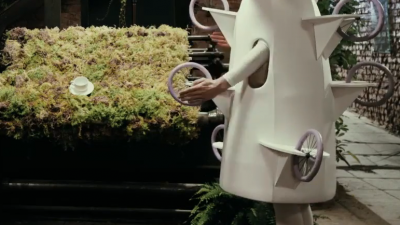Land Rover’s reborn Discovery wades in with off-road ability, upscale family smarts
“Discovery” is one of the auto industry’s all-time great names, a moniker incredibly well-suited to an SUV with a history of providing legitimatelegendary off-road chops. So it was quite a surprise when Land Rover walked away from the appellation in the mid-2000s in favor of an alphanumeric soup — LR3 and then LR4, model names that that sounded they belonged to a line of icemakers.
Well, the rebranding experts have evidently been put out to pasture in Great Britain, because Land Rover has finally, mercifully restored the Discovery nameplate for this fifth-generation model. And it’s not just the name that’s new, the Green Oval has reworked the seven-seat SUV from stem to stern for its Paris Motor Show debut. It’s given it a new chassis, a new range of engines, new cabin tech and a sleek set of familial clothes could be the source of some consternation among Land Rover faithful.
Don’t get me wrong, it’s not that the 2017 Discovery isn’t handsome. It is. But it’s also deeply familiar, looking perhaps too similar to other current-day Land Rovers, especially the Range Rover Sport and, somewhat confusingly, the Discovery Sport, a less-expensive model family that also has three rows of seats. As the last stylistic holdout of Land Rover’s rectilinear school of design that defined its previous-generation models, the old LR4 stood out thanks to its upright utilitarianism, a style that somehow managed to be both honest and premium.
Presaged by 2014’s Discovery Vision Concept, this new generation stands out more in its details than in its overall appearance. It’s actually the Discovery’s rear-third that is its most noteworthy aspect, thanks in part to a subtle stepped roofline above the second row. The latter is a design trait that goes back to the original 1989 Series 1 Discovery, which itself had a more overt rise in its roof to accommodate the stadium-style third-row seating.
The new Disco’s rear end is also its most distinctive vantage because of its unique horizontally oriented taillamps. These bookend an asymmetrical recess that doubles as the license-plate pocket and liftgate handle. It’s a clever bit of design that harks back to its predecessor’s external spare tire mounts.
Thanks to its new aluminum-intensive unibody chassis, Land Rover says the Discovery is a whopping 1,000 pounds or so lighter than its steel ladder-framed predecessor. That’s a remarkable achievement, especially when the new architecture manages to be stiffer. Even so, despite its 85-percent aluminum chassis, the Disco does not yet qualify as light — it still weighs over 4,800 pounds.
Note the stepped roofline with panoramic glass and the asymmetrical tailgate insert.
In the US, the Discovery will be available with the buyer’s choice of Jaguar-Land Rover’s 3.0-liter supercharged gasoline-powered V6 with 340 horsepower and 332 pound-feet of torque, or a Td6 turbodiesel of the same displacement. We’ve held the latter in high regard in the Range Rover and Range Rover Sport models, and it’s tuned here to deliver 254 horsepower and a healthy 443 pound-feet of torque. According to Land Rover, the gas engine hits 60 in 6.9 seconds, while the Td6 needs 7.7.
Perhaps most importantly, the new Discovery has received a completely new interior, one whose highlights should be familiar to those who have sampled recent JLR products. The dashboard’s centerpiece is a 10-inch touchscreen display powered by the company’s InControlTouch Pro infotainment architecture.
The reconfigurable system includes advanced features such as door-to-door navigation (even if that includes a walking portion), downloadable apps, and Wi-Fi for up to eight devices. It’s a much more capable system than its ponderously slow predecessor, but its usability still trails that of a number of other rival systems.
A large center console includes storage, cupholders and JLR’s ubiquitous rotary shifter.
Innovative convenience features include Intelligent Seat Fold — powered second- and third-row seats that can be raised and lowered both by switches and by smartphone app. Could be useful for those moments when you find yourself in the store having unexpectedly splurged on a mop or a new Eames Lounger, perhaps.

























Comments